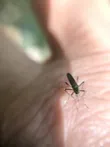Harmful Effects of Aedes sierrensis
A species of Mosquito
Aedes sierrensis bites can transmit diseases to humans, though the likelihood varies. Transmission occurs when females bite for blood, potentially causing irritation, redness, and swelling. Some diseases may be serious and require medical attention, while others cause minor discomforts. Preventive measures can reduce the risk of bites and associated health issues.
Does the Aedes sierrensis bite humans or animals?
Harmful Facts About Aedes sierrensis
What Type of Pest Is Aedes sierrensis?









AI entomologist in your pocket
Scan QR code to download

